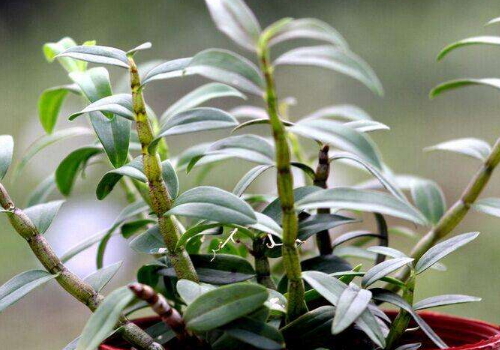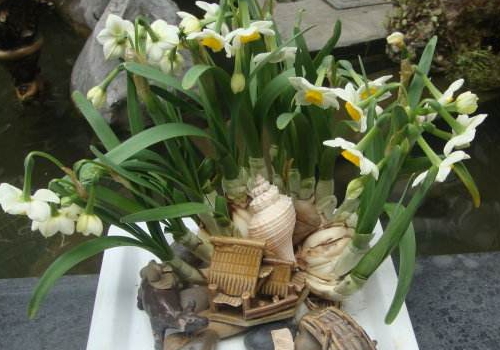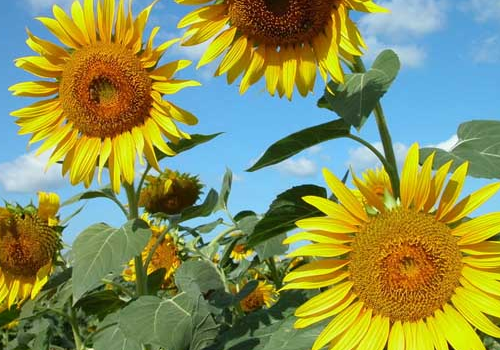What kind of fertilizer does Dendrobium use? the cause of yellowing of leaves and how to do it?
Dendrobium candidum, I believe many people have seen it, there are some exquisite when planting. What fertilizer is good for Dendrobium candidum? The reason why the leaves turn yellow and how to do it?
What fertilizer is good for Dendrobium candidum?
Fertilizer: the nutrition of aerial root of Dendrobium candidum mainly depends on the blue bacteria of the root system to fix the free nitrogen in the air, but the application of appropriate fertilizer can promote the stem to increase and the leaves to be fat. After the germination of the new root, you can begin to spray liquid fertilizer, such as potassium dihydrogen phosphate, or potassium dihydrogen phosphate plus urea, etc., with a concentration of about 0.1%, usually sprayed once in 10 days. After 1 year and 2 months, when the transplanted seedlings have gradually adapted to the new environment and the new roots have grown lO cm or so, slow-acting granular fertilizer can be applied to help them thrive.

Causes of yellowing of leaves of Dendrobium candidum and what to do:
1. Matrix discomfort
Reason: the aerial root of Dendrobium candidum is exposed in the air, absorbing air and Rain Water.
Methods: bark is the first choice for matrix materials, followed by sawdust, all of which need to be crushed, sterilized and fermented, usually mixed with several materials and substrates of different thickness.
2. The matrix is too wet
Reason: too much watering causes the substrate to be too wet and the roots to rot.
Method: potted Dendrobium candidum needs to be watered every other week or two weeks, after watering thoroughly, usually spray, need to control the balcony air circulation and other factors. The stem and rhizome of Dendrobium candidum are not dead, so they can germinate again after spring, but watering should be controlled to prevent rotting roots.
3. Lack of water and drought
Cause: lack of water leads to yellow leaves. Some growers control too much water, coupled with the current relatively low humidity, which leads to the occurrence of yellow leaves. Although it is winter now, water control should not be excessive, especially Dendrobium candidum planted in bed. The phenomenon of yellow leaves caused by lack of water is more common in winter.
Method: watering is suitable for slightly acidic to neutral water, there will be too much calcium, magnesium and other minerals in bogey water. Sufficient water is required in spring, summer and early autumn, and gradually enter a dormant state after the Mid-Autumn Festival, and the amount of watering should be reduced until watering is completely stopped. But before the leaves turn yellow, they begin to reduce watering, further decrease with the yellowing and shedding of the leaves, and stop watering when the leaves fall out. In North China, it is necessary to maintain a high indoor air humidity after the water is cut off to avoid pseudo-bulb drying and shrinking. If the room is too dry, the basin can be watered every 1 to 2 weeks.
4. There are too many miscellaneous bacteria
The reason: there are too many miscellaneous bacteria in the substrate, and the lack of competitiveness of symbiotic bacteria in the root system leads to the yellowing of leaves.
Methods: fermented bark or sawdust, coconut shell, bagasse, rotten fallen leaves or moss should be fully dried in the sun and treated with caprylic acid to kill the remaining pests and eggs in the soil.
5. The light is too strong
Reason: the growth environment of Dendrobium candidum needs to be controlled in a humid and semi-shady place, if the sun is too strong, it will make Dendrobium feel dry, which is not conducive to its air root breathing, so it is very important to control its planting environment.
Method: sufficient light, spring, summer and autumn, shading amount is controlled between 30% and 50%, sufficient light can form a large number of flower buds.
6. The temperature is too high
Reason: the planting temperature of Dendrobium candidum is too high and the leaves turn yellow due to overheating.
Method: Dendrobium does not like the high temperature in summer, it often stops growing in the hot summer and should be placed in a well-ventilated place. After the flower bud grows, the greenhouse temperature of 20 ℃ to 25 ℃ during the day and 15 ℃ at night should be kept, not too high or too low, otherwise it is easy to cause the bud to fall off.
7. Lack of potash fertilizer
Reason: the leaves of Dendrobium candidum start yellowing from the leaf tip, and then the whole piece of yellow and then fall off, this phenomenon may be the lack of potassium, which will make the leaf tip yellowing first, and then the whole piece will fall off.
Method: spray potash fertilizer.
All right, that's all for the introduction of the solutions to the causes of Dendrobium candidum fertilizer and yellow leaves, all of you understand.
Pot Dendrobium candidum leaves yellowing how to do, change the basin soil to control watering / proper shading
As one of the most useful varieties of Dendrobium, Dendrobium candidum is very effective, it not only blossoms, but also inherits the medicinal value of Dendrobium, and can treat various diseases of the human body. However, in the process of breeding, many flower friends often encounter a problem, that is, the leaves are yellow, that pot Dendrobium candidum leaves yellow how to do? Today, the editor will solve this problem.
First, how should the leaves of potted Dendrobium turn yellow? find the cause.
As a potted plant, Dendrobium candidum is not easy to raise, once we are a little negligent, such as not in accordance with the cultivation method of Dendrobium candidum to maintain, its leaves may appear signs of yellowing. At that time, the flower friends must be in a hurry. In order to solve this problem, the editor summarized five reasons for the yellowing of the leaves of Dendrobium candidum, and attached a solution. Let's move on.
2. Causes and solutions of yellowing of leaves of Dendrobium candidum.
1. Soil discomfort
In fact, there are many reasons why the leaves of Dendrobium candidum turn yellow, but the first thing we should consider is the soil. With regard to soil problems, it can be divided into two situations, as follows:
① soil is not suitable.
Dendrobium candidum has high requirements for soil, if the soil is not suitable, it will make the roots inactive, resulting in aerial roots exposed in the air, a problem will occur over a long time, its performance is that the leaves of Dendrobium candidum are yellowing.
Solution: change the pot soil, put a large stone in the flowerpot, cover it with a layer of permeable stone, and then cover the stone with a mixture of fermented pine bark and sawdust. Note that the mixture needs to be crushed, sterilized and fermented.
There are many miscellaneous bacteria in ② soil.
Even if the soil is selected, if there is no disinfection, resulting in too many soil miscellaneous bacteria, it will lead to the lack of symbiotic competitiveness of Dendrobium candidum roots, resulting in the symptoms of leaf yellow.
Solution: dry the soil, that is, the mixture in the sun, and then kill the pests and eggs left in the soil with caprylic acid. After a period of time, Dendrobium candidum will return to health.
2. Improper watering
In addition to soil, improper watering is also one of the reasons for the yellowing of Dendrobium leaves. The watering problem is also divided into two situations: one is too much watering, the other is too little watering, the details are as follows:
① watered too much
Dendrobium candidum likes a humid environment, so we should water it frequently to keep the basin soil moist. But once too much watering causes the soil to be too wet, it will cause the roots of Dendrobium candidum to rot and the leaves may turn yellow as a result.
Solution: the stem and rhizome of Dendrobium candidum are not dead, so they can germinate again after the spring is warm, but watering should be controlled: watering every other week or two weeks, after watering thoroughly, spray at ordinary times.
Too little watering for ②
Watering too much does not work, nor too little, it will also cause the leaves of Dendrobium candidum to turn yellow. Once the watering is too little or impermeable, it will lead to the drying of the basin soil, and the leaves will show the symptoms of leaf yellow due to insufficient water absorption.
Solution: watering is suitable for slightly acidic to neutral water, sufficient water is required in spring, summer and early autumn, and watering should be reduced after the Mid-Autumn Festival until watering is completely stopped. Before the leaves of Dendrobium candidum yellowed, it began to reduce watering, further reduced with the yellowing and shedding of the leaves, and stopped when the leaves fell out.
3. Fertilizer problem
After watering, let's talk about fertilization, which is also one of the reasons why the leaves of Dendrobium candidum turn yellow. Dendrobium candidum needs fertilizer, but once the fertilization is improper or too little, there will be such symptoms: the leaves start yellowing from the leaf tip, and then the whole piece yellowed and then fell off.
Solution: encounter the above situation, this may be caused by the lack of potassium, so it is easy to solve, just spray the right amount of potash fertilizer.
4. The light is too strong
Dendrobium candidum likes damp and semi-shady places, although it needs light, it is also astigmatism. Once the light is too strong, it will make Dendrobium feel dry, which is not conducive to its air root breathing, resulting in the phenomenon of leaf yellow.
Solution: while keeping Dendrobium candidum in sufficient light, it should be properly shaded, such as spring, summer and autumn, the amount of shading should be controlled between 30% and 50%, and the light is weak in winter, so the potted plants can be moved to the outside to bask in the sun.
5. The temperature is too high
Dendrobium candidum is very sensitive to the problem, it is not cold-resistant or heat-resistant, once the temperature is too high, it may cause leaves yellowing, or even cause buds to fall off.
Solution: Dendrobium candidum does not like the high temperature, so it should be put in a well-ventilated place in hot summer. If the temperature is too high, it should be cooled down.
Generally speaking, Dendrobium candidum is not easy to raise, coupled with many flower friends are novice, so there will inevitably be leaf yellow symptoms. However, after reading the full text, I believe you have a bottom in your mind. If there is a Ye Huang problem, you can follow the above method. About Dendrobium candidum leaves yellowing, the editor introduced here, hoping to bring help to everyone.
What are the reasons for the yellowing of orchid leaves?
Many people in the breeding of hanging orchids, there will be symptoms of yellow leaves, and hanging orchids appear this symptom, how is caused? The author introduces the habits of Cymbidium and the reason why the leaves are yellowing for users. If the hanging orchid in your home also appears this symptom, that is just right, let's take a look!
Growth habits of Cymbidium
Magnolia also known as and hanging orchid, bluegrass, folding crane orchid, etc., the plant originally grew with South Africa. It is a comfortable and perennial herb with slender leaves, like orchids, with green or stripes in the middle, followed by a flower diameter drawn from the leaves and stolons at the top of the leaves. The flowers are white, and it is often seen that 4 flowers grow together. Of course, some flowers are purple. Each plant has about three to five seeds, flowering in May and fruiting in August. Secondly, planting Cymbidium also has the effect of purifying air, and the plant can also be used as medicine.
The reason for the yellowing of the leaves of Cymbidium
When raising Cymbidium, it is necessary to understand the nature of the plant, that is, Cymbidium likes warm and humid places, and its adaptability is also very strong, and its drought resistance is also very good, and no matter what kind of soil it is, it can be cultured successfully. Secondly, it is very good to grow in a good drainage and loose and fertile sandy soil, and the reasons for the yellowing of leaves can be divided into the following: 1 excessive fertilization exceeds the growth needs of Cymbidium (2) the potted soil has not been changed for a long time; (3) the light is insufficient; (4) the air permeability and drainage in the soil are not good.
The solution to the yellowing of Cymbidium leaves
The above is the reason for the yellowing of the leaves arranged by the editor for you, and the solution is also very simple. Of course, in the process of breeding, you should also pay attention to which reason the leaves of the plant are yellowing. 1 should immediately stop applying fertilizer, and irrigate more water, or clean the fertilizer at the root and replace the new soil. 2 the new soil has not been replaced for a long time, and the elements in the soil are exhausted, so the plants will lack nutrients and the leaves will turn yellow, so users should immediately change the soil and fertilize. 3 in the process of breeding Cymbidium, it is necessary to ensure that the plant can see the eye sunlight for more than 4 hours at the earliest, increase the green leaves of the leaves, and pay attention to avoid the exposure of strong light. (4) it is necessary to ensure that the potted plants have the same water quality and good air permeability in the soil.
Editor reminded: I believe that after reading the above, users should understand the reasons for the yellowing of hanging orchid leaves and the solution! In the process of breeding, the first is to understand the habits of plants, and the second is to make timely deployment according to conditions. Of course, it can also avoid the yellowing of leaves.
Yew bonsai price Japanese cherry blossom picture red maple price Dendrobium candidum planting method is rhododendron easy to raise
- Prev

What kind of pot do you use to grow flowers? what if there are small flying insects?
Growing flowers, I believe many people have done it, although it is simple, but there are still some exquisite. What kind of pot should I use to grow flowers? What if there are little flying bugs? What kind of pot is good for growing flowers: ceramic flowerpots, ceramic flowerpots are made of all kinds of soil, processed and calcined in a kiln. Due to the different processing methods, it can be divided into: tile basin
- Next

What kind of plant planting method does sunflower belong to
The role of sunflowers is huge, we can eat melon seeds cooking oil and so on are from sunflowers, so what kind of plant does sunflower belong to? How to grow sunflowers? What kind of plant does sunflower belong to: sunflower belongs to angiosperm. Sunflower belongs to angiosperm in classification, and its fruit is achene, commonly known as sunflower seed.
Related
- Fuxing push coffee new agricultural production and marketing class: lack of small-scale processing plants
- Jujube rice field leisure farm deep ploughing Yilan for five years to create a space for organic food and play
- Nongyu Farm-A trial of organic papaya for brave women with advanced technology
- Four points for attention in the prevention and control of diseases and insect pests of edible fungi
- How to add nutrient solution to Edible Fungi
- Is there any good way to control edible fungus mites?
- Open Inoculation Technology of Edible Fungi
- Is there any clever way to use fertilizer for edible fungus in winter?
- What agents are used to kill the pathogens of edible fungi in the mushroom shed?
- Rapid drying of Edible Fungi

